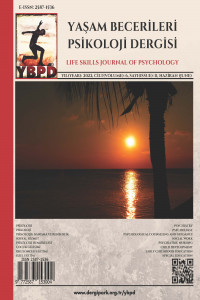Bireysel Karşılıklılık Normu Ölçeğinin Türkçe Uyarlaması ve Güvenirlik ve Geçerlik Analizi
Karşılıklılık, bireylerin diğerlerinin olumlu ve olumsuz davranışlarına aynı şekilde karşılık vermesini salık veren normdur. Bu kavram gerek sosyal psikolojide gerekse diğer sosyal bilimlerde sıkça kullanılmaktadır. Bu çalışmada Bireysel Karşılıklılık Normu Ölçeği Türkçeye çevrilmiş ve bu çevirinin güvenirlik ve geçerliğine dair bulgular elde edilmiştir. Bu ölçek Pozitif Karşılıklılık Normu (PKN), Negatif Karşılıklılık Normu (NKN) ve Karşılıklılığa İnanç (Kİ) olmak üzere her biri 9 madde içeren 3 alt boyuttan oluşmaktadır. 328 üniversite öğrencisinden anket yoluyla veri toplanmış, ölçeğin yapı geçerliği açımlayıcı ve doğrulayıcı faktör analizi ile incelenmiştir. Bulgular toplamda 3 maddenin hem açımlayıcı hem doğrulayıcı faktör analizinde beklenen şekilde işlemediğini, diğer maddelerin beklenen faktör yüklerine sahip olduğunu ve modelin uyum değerlerinin yeterli olduğunu göstermiştir (PKN ve NKN için χ²(116)=219, p<0.001, χ²/df=1.887, CFI=0.908, RMSEA=0.051, SRMR=0.060., Kİ için χ²(13)=32.1, p=0.002, χ²/df=2.47, CFI=.915, RMSEA=.066, SRMR=043). Aynı zamanda, beklendiği gibi ölçeğin üç alt boyutu arasında pozitif korelasyon mevcuttur. Ölçeğin alt boyutlarının güvenirlik katsayıları ise PKN için .71, NKN için .76, Karşılıklılık İnancı için ise .62’dir. İlgili bir değişken olan prososyal yönelim ise yalnızca Negatif Karşılıklılık Normu ile negatif korelasyon göstermiştir. Bulgular ölçeğin tatmin edici güvenirlik ve geçerlik değerlerine sahip olduğunu ve karşılıklılık normunu içselleştirme düzeyinde bireysel farklılıkların ölçülmesinde kullanılabileceğini göstermektedir.
Anahtar Kelimeler:
Karşılıklılık Normu, Bireysel Farklılıklar, Sosyal Değer Yönelimi
The Turkish Adaptation and The Reliability and Validity Analysis of The Personal Norm of Reciprocity Scale
Reciprocity is a norm which suggests that people should reciprocate the negative and positive behaviors of others. This concept is widely used in both social psychology and other social sciences. In this study, The Personal Norm of Reciprocity Scale is translated into the Turkish language and its reliability and validity values are acquired. This scale consists of 3 sub-factors of 9 items, named Positive Reciprocity Norm (PRN), Negative Reciprocity Norm (NRN), and Belief in Reciprocity (BR). A survey is conducted on 328 college students and the structural validity of the scale is examined via an explanatory and a confirmatory factor analysis. The results indicated that 3 of the items failed to function as expected both in exploratory and confirmatory factor analysis. The rest of the items had expected factor loadings and the fit values of the models are satisfactory (χ²(116)=219, p<0.001, χ²/df=1.887, CFI=.908, RMSEA=.051, SRMR=.060 for PRN and NRN χ²(13)=32.1, p=0.002, χ²/df=2.47, CFI=.915, RMSEA=.066, SRMR=043 for BR). Moreover, as expected, the three sub-scales of the scales are positively correlated to each other. The reliability coefficient is .71 for PRN, .76 for NRN, and .62 for BR. Prosocial value orientation, a related construct, is only negatively related to the Negative Reciprocity Norm. These results indicate that the scale has satisfactory reliability and validity measures and it can be used to measure the individual differences in the levels of internalization of the norm of reciprocity.
___
- Burger, J.M., Sanchez, J., Imberi, J.E. ve Grande, L.R. (2009). The norm of reciprocity as an internalized social norm: Returning favors even when no one finds out. Social Influence, 4(1), 11-17.
- Cialdini, R.B., Vincent, J.E., Lewis, S.K., Catalan, J., Wheeler, D., & Darby, B.L. (1975). Reciprocal concessions procedure for inducing compliance: The door-in-the-face technique. Journal of Personality and Social Psychology, 31(2), 206-215.
- Eder, P., Aquino, K., Turner, C., Reed, A. (2006). Punishing those responsible for the prison abuses at Abu Ghraib: The influence of the negative reciprocity norm (NRN). Political Psychology, 27(6), 807-821.
- Eisenberger, R., Lynch, P., Aselage, J. ve Rohdieck, S. (2004). Who takes the most revenge? Individual differences in negative reciprocity norm endorsement. Personality and Social Psychology Bulletin, 30(6), 787-799.
- Gouldner, A.W. (1960). The norm of reciprocity: A preliminary statement. American Sociological Review, 161-178.
- Kolm, S. C. (2008). Reciprocity: An economics of social relations. Cambridge University Press.
- Liebrand, W. B. ve McClintock, C. G. (1988). The ring measure of social values: A computerized procedure for assessing individual differences in information processing and social value orientation. European Journal of Personality, 2(3), 217-230.
- Mauss, M. (2018). Armağan üzerine deneme. (N. Özyıldırım, çev.). İstanbul: Alfa Yayınları.
- Mitchell, M.S., Ambrose, M.L. (2007). Abusive supervision and workplace deviance and the moderating effects of negative reciprocity beliefs. Journal of Applied Psychology, 92(4), 1159-1168.
- Perugini, M., Gallucci, M. (2001). Individual differences and social norms: The distinction between reciprocators and prosocials. European Journal of Personality, 15(1), 19-35.
- Perugini, M., Gallucci, M., Presaghi, F. ve Ercolani, A.P. (2003). The personal norm of reciprocity. European Journal of Personality, 17(4), 251-283.
- Polanyi, K. (2009). Büyük dönüşüm: Çağımızın siyasal ve ekonomik kökenleri. İstanbul: İletişim Yayıncılık. Schindler, S., Reinhard, M. A. ve Stahlberg, D. (2012). Mortality salience increases personal relevance of the norm of reciprocity. Psychological Reports, 111(2), 565-574.
- Schindler, S., Reinhard, M.A., Stahlberg, D. (2013). Tit for tat in the face of death: The effect of mortality salience on reciprocal behavior. Journal of Experimental Social Psychology, 49(1), 87-92.
- The jamovi project (2021). jamovi. (Version 2.2) [Computer Software]. Retrieved from jamovi.org.
- Umphress, E.E., Bingham, J.B., & Mitchell, M.S. (2010). Unethical behavior in the name of the company: The moderating effect of organizational identification and positive reciprocity beliefs on unethical pro-organizational behavior. Journal of Applied Psychology, 95(4), 769-780.
- ISSN: 2587-1536
- Başlangıç: 2017
- Yayıncı: Muhammed YILDIZ
Sayıdaki Diğer Makaleler
Gerçeklik Terapisi Açısından Gelecek Günler Filminin Analizi
Yıldız BİLGE, Esin SEZGİN, Hazal ERSAL
Nesibe OLGUN KAVAL, Nimet Serap GÖRGÜ AKÇAY, Gamze KILIÇ
Dürtüsel Satın Alma Eğilimi: Bilişsel Faktörler, Kişilik Özellikleri ve Duygulanımın Rolü
Bireysel Karşılıklılık Normu Ölçeğinin Türkçe Uyarlaması ve Güvenirlik ve Geçerlik Analizi
